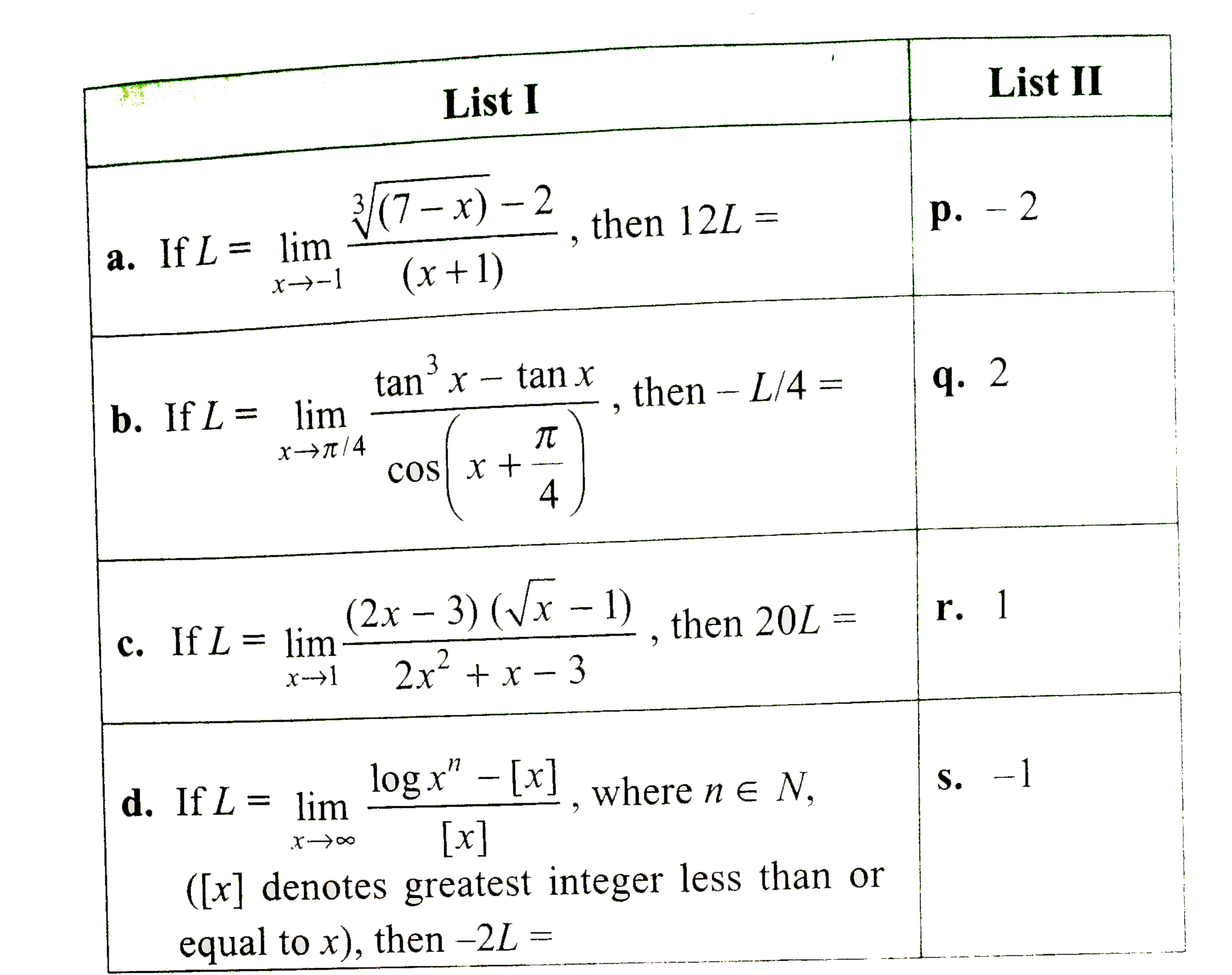Given (lim)x→0f(x)x2=2,where[.] denotes the greatest integer function, then (a) (lim)x→0[f(x)]=0 (b) (lim)x→0[f(x)]=1 (c)(lim)x→0[f(x)x] does not exist (d)(lim)x→0[f(x)x] existsSolution in Tamil
13
14
12
23
The correct Answer is:A, C
Since x2>0 and limit equals 2,f(x) must be a positive quantity. Also, since limx→0f(x)x2=2. Denominator → zero and limit is finite. Therefore, f(x) must be approaching zero or limx→0[f(x)]=0+.
Hence, limx→0[f(x)x]=0+.
limx→0+[f(x)x]=limx→0+[xf(x)x2]=0
and limx→0−[f(x)x]=limx→0−[xf(x)x2]=−1
Hence, limx→0[f(x)x] does not exist.
Topper's Solved these Questions
- LIMITSBOOK - CENGAGECHAPTER - LIMITSEXERCISE - Exercise (Comprehension)
20 Videos
- LIMITSBOOK - CENGAGECHAPTER - LIMITSEXERCISE - Exercise (Matrix)
5 Videos
- LIMITSBOOK - CENGAGECHAPTER - LIMITSEXERCISE - Exercise (Single)
76 Videos
- JEE 2019BOOK - CENGAGECHAPTER - JEE 2019EXERCISE - Chapter 10
9 Videos
- LINEAR COMBINATION OF VECTORS, DEPENDENT AND INDEPENDENT VECTORSBOOK - CENGAGECHAPTER - LINEAR COMBINATION OF VECTORS, DEPENDENT AND INDEPENDENT VECTORSEXERCISE - DPP 1.2
10 Videos
Similar Questions
Find the domain of f(x)=√|x|−{x} (where {⋅} denots the fractional part of x).
View SolutionMatch the following lists:

View Solution(lim)x→0[sin(sgn(x))(sgn(x))], where[.] denotes the greatest integer function, is equal to (a)0 (b) 1 (c) −1 (d) does not exist
View SolutionIf y = y(x) is the solution of the differential equation, xdydx+2y=x2 satisfying y(1) = 1, then y(12) is equal to
View SolutionThe number of integral values of p for which (p+1)ˆi−3ˆj+pˆk,pˆi+(p+1)ˆj−3ˆk and −3ˆi+pˆj+(p+1)ˆk are linearly dependent vectors is q
View SolutionLet f(x)={cos[x],x≥0|x|+a,x<0 The find the value of a, so that (lim)x→0 f(x) exists, where [x] denotes the greatest integer function less than or equal to x .
View SolutionWhich of the following limits tends to unity? (a)(lim)x→0sin(tanx)sinx (b) (lim)x→π2sin(cosx)cosx (lim)x→0sinex−1x (d) (lim)x→0√1+x−√1−xx
View SolutionIf f(x)=x(e|x|+[x]−2|x|+[x]) then (where [.] represents the greatest integer function) (lim)x→0+f(x)=−1 b. (lim)x→0−f(x)=0 c. (lim)x→0□f(x)=−1 d. (lim)x→0□f(x)=0
View SolutionEvaluate: (lim)x→0sinxx,where[.] represents the greatest integer function.
View SolutionEvaluate: (lim)x→0ex^2−cosxx2
View SolutionEvaluate: (lim)x→0ex+e−x−2x2
View SolutionGiven a real-valued function f such that f(x)=⎧⎪ ⎪⎨⎪ ⎪⎩tan2{x}(x2−[x]2)√{x}cot{x},forx<0,fx>0 Where [x] is the integral part and {x} is the fractional part of x, then (lim)x→0+f(x)=1 , (lim)x→0−f(x)=cot1, cot−1((lim)x→0−f(x))2=1, tan−1((lim)x→0+f(x))=π4
View SolutionGiven (lim)x→0f(x)x2=2,where [.] denotes the greatest integer function, then (A) (lim)x→0[f(x)]=0 (B) (lim)x→0[f(x)]=1 (C)(lim)x→0[f(x)x] does not exist (D)(lim)x→0[f(x)x] exists
View SolutionIf [.] denotes the greatest integer function, then (lim)x→0xa[bx] a. ba b. 0 c. ab d. does not exist
View SolutionIf f(x)=x(e|x|+[x]−2|x|+[x]) then (where [.] represents the greatest integer function) (lim)x→0+f(x)=−1 b. (lim)x→0−f(x)=0 c. (lim)x→0□f(x)=−1 d. (lim)x→0□f(x)=0
View SolutionWhich of the following limits tends to unity? (a)(lim)x→0sin(tanx)sinx (b) (lim)x→π2sin(cosx)cosx (c) (lim)x→0sinex−1x (d) (lim)x→0√1+x−√1−xx
View Solution